Virginia Creeper (Parthenocissus quinquefolia) Profile
Written by Iris
Aug 13 2021
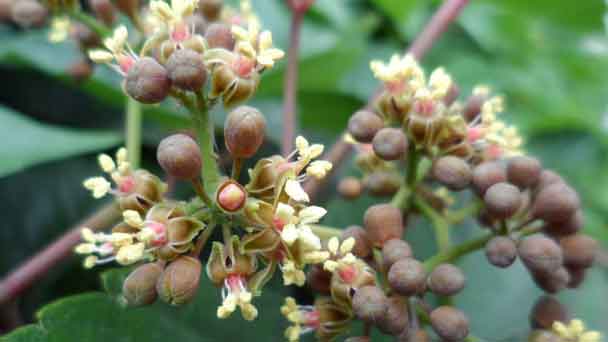
The Virginia creeper is a native perennial, fast-growing, deciduous, woody vine that can climb along the ground or almost anything to a height of more than 50 feet and spread over 35 feet. The leaves of Virginia creeper consist of five small green leaves with toothed edges and are 2 to 6 inches long. In autumn, the leaves are a vivid red and turn maroon.
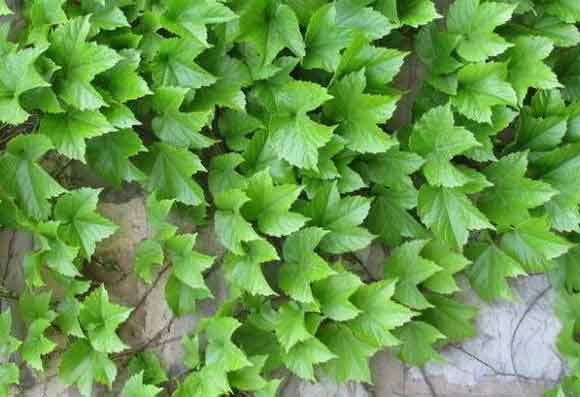
Virginia Creeper (Parthenocissus quinquefolia) Distribution Area
Stroll through almost any woodland setting in the United States and you’ll probably see Virginia creeper (Quinquefolia). This native climbing vine is indigenous to most of the country and clambers over rock walls, trees and fences. It is hardy in USDA Plant Hardiness Zones 3B through 10. It was later also given to the closely related P. tricuspidata, which is a native of China and Japan. The Asian species is often seen growing over rocks in Chinese gardens, or alongside other vines such as wisteria. The Chinese consider this plant so vigorous that they call it ‘Mountain-climbing Tiger’.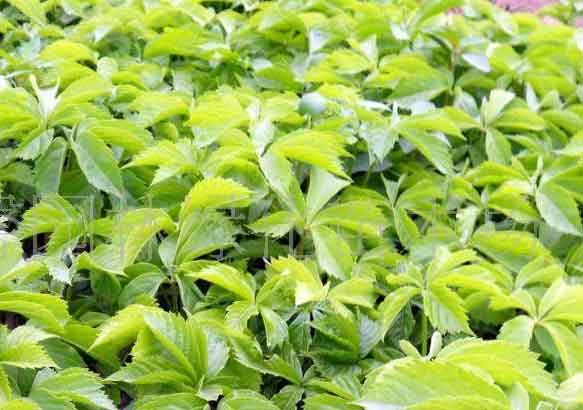
Snap off a section of the growing tip of Virginia creeper in late spring or summer. Choose a section that is several inches long with the newest leaves smaller than the older ones and the woody vine just beginning to harden. Alternatively, cut off an end section of an older, harder, more woody vine that contains several leaf nodes in the winter when the Virginia creeper is dormant. Do not use sections of the vine that have flowers and use only healthy parent stock. Keep the cutting moist until time to plant it.
Pinch off the leaves from the lower half of the cutting. Dip the cut end of the cutting in rooting hormone powder, if desired.
Stick the cuttings upright into the prepared rooting medium with the cut end down. Push it into the medium to about half its length. If you are rooting more than one cutting, place them far enough apart so their leaves do not overshadow one another.
Transplant the cutting into a flowerpot filled with moist, sterile potting soil in a few weeks when it has roots an inch or so long. Continue to keep the Virginia creeper in a bright location and keep the soil moist. After a few weeks, when the plant is stable in the pot, transplant it outdoors, soil and all, to the desired location.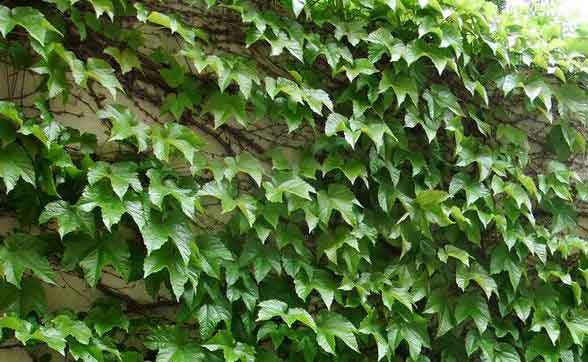
April – Oct this Maple should be irrigated 2 x weekly.
Nov – Mar this Maple should be irrigated 2 x monthly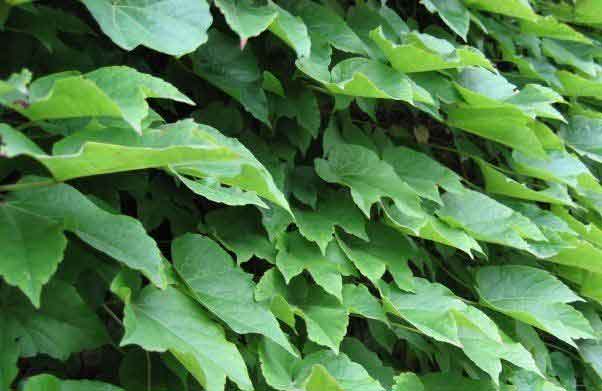
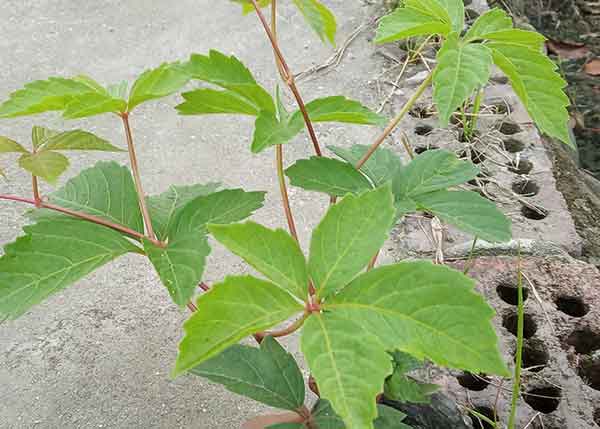
Virginia creeper‘Engelmanii’: This variety has small, attractive leaves and clings to walls and fences better than other varieties.
Virginia creeper‘Monham’: Like some varieties of ivy, this cultivar has leaves with white variegations.
Virginia creeper‘Variegata’: This plant doesn't grow as vigorously as other varieties, but its leaves are variegated with yellow and white. In the fall, these variegations become pink and red.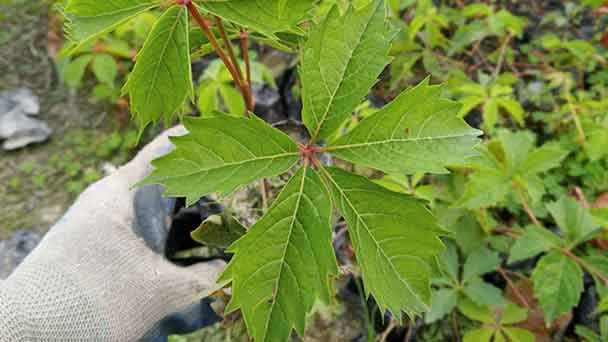
Virginia Creeper (Parthenocissus quinquefolia) PictureVirginia Creeper (Parthenocissus quinquefolia) InfoEcological Habits of Virginia Creeper (Parthenocissus quinquefolia)How to Grow and Care for Virginia Creeper (Parthenocissus quinquefolia)Uses of Virginia Creeper (Parthenocissus quinquefolia)
Virginia Creeper (Parthenocissus quinquefolia) Picture

Virginia Creeper (Parthenocissus quinquefolia) Info
| Botanical Name | Parthenocissus quinquefolia |
| Common Name | Virginia creeper, Victoria creeper, five-leaved ivy, five-finger, woodbine |
| Plant Type | Deciduous perennial vine |
| Mature Size | 30 to 50 feet |
| Sun Exposure | Full sun to part shade |
| Soil Type | Sandy, clay, loamy |
| Soil pH | 5.1 to 7.5 |
| Bloom Time | Summer |
Ecological Habits of Virginia Creeper (Parthenocissus quinquefolia)
Virginia creeper is a carefree plant. It is a deciduous, perennial vine with a woody stem. The plant will bloom from June to July with green, inconspicuous flowers. They turn into round ball-like fruits, which persist on the vine and add interest.Virginia Creeper (Parthenocissus quinquefolia) Distribution Area
Stroll through almost any woodland setting in the United States and you’ll probably see Virginia creeper (Quinquefolia). This native climbing vine is indigenous to most of the country and clambers over rock walls, trees and fences. It is hardy in USDA Plant Hardiness Zones 3B through 10. It was later also given to the closely related P. tricuspidata, which is a native of China and Japan. The Asian species is often seen growing over rocks in Chinese gardens, or alongside other vines such as wisteria. The Chinese consider this plant so vigorous that they call it ‘Mountain-climbing Tiger’.

How to Grow and Care for Virginia Creeper (Parthenocissus quinquefolia)
How to Grow Virginia Creeper (Parthenocissus quinquefolia)
- With Cuttings
Snap off a section of the growing tip of Virginia creeper in late spring or summer. Choose a section that is several inches long with the newest leaves smaller than the older ones and the woody vine just beginning to harden. Alternatively, cut off an end section of an older, harder, more woody vine that contains several leaf nodes in the winter when the Virginia creeper is dormant. Do not use sections of the vine that have flowers and use only healthy parent stock. Keep the cutting moist until time to plant it.
Pinch off the leaves from the lower half of the cutting. Dip the cut end of the cutting in rooting hormone powder, if desired.
Stick the cuttings upright into the prepared rooting medium with the cut end down. Push it into the medium to about half its length. If you are rooting more than one cutting, place them far enough apart so their leaves do not overshadow one another.
Transplant the cutting into a flowerpot filled with moist, sterile potting soil in a few weeks when it has roots an inch or so long. Continue to keep the Virginia creeper in a bright location and keep the soil moist. After a few weeks, when the plant is stable in the pot, transplant it outdoors, soil and all, to the desired location.

How to Care for Virginia Creeper (Parthenocissus quinquefolia)
- Light
- Soil
- Water
April – Oct this Maple should be irrigated 2 x weekly.
Nov – Mar this Maple should be irrigated 2 x monthly
- Temperature and Humidity
- Fertilizer
- Pruning

Uses of Virginia Creeper (Parthenocissus quinquefolia)
Ecosystem Uses
The shelter afforded by Virginia creeper provides places for warblers and other songbirds to nest and gain protection from predators and harsh weather. It also shelters toads and insects, which in turn are food for many birds and mammals. Virginia creeper also offers food in the form of pollen for bees that pollinate its flowers and berries for songbirds, skunks and chipmunks. Deer are known to occasionally munch on the leaves.Medicinal Uses
Virginia creeper is reputed to have been used by humans to alleviate jaundice, headaches, rheumatism, bunions, respiratory ailments, and skin irritations such as poison sumac rash. (Caution: We are not recommending the use of these plants for medicinal or food purposes. Many plants are poisonous or harmful if eaten or used externally. The information on food and medicinal value is only added for interest. This information has been gathered from books and its accuracy has not been tested.)
Varieties of Virginia Creeper (Parthenocissus quinquefolia)
Although common Virginia creeper grows well in most yards, you might try several improved horticultural varieties for increased pest resistance. Below are a few to consider:Virginia creeper‘Engelmanii’: This variety has small, attractive leaves and clings to walls and fences better than other varieties.
Virginia creeper‘Monham’: Like some varieties of ivy, this cultivar has leaves with white variegations.
Virginia creeper‘Variegata’: This plant doesn't grow as vigorously as other varieties, but its leaves are variegated with yellow and white. In the fall, these variegations become pink and red.

Virginia Creeper (Parthenocissus quinquefolia) Companion Plants
Grow Virginia creeper up a wall, building, or fence where it can remain for years. Plant Virginia creeper on non-wooden surfaces since the lush growth can cause the wood to mold and rot over time. If growing against a wooden house, consider building a trellis 3 feet away from the building so plenty of air can flow behind the vine and keep the wood dry. Grow Virginia creeper over walls or on banks to cover a slope. You can often see it rambling in wild areas over other trees and shrubs.
Latest Updated
- Benefits of Bugleweed - 7 Science-backed Health Benefits
- Bugleweed Dangers & Side Effects - Is It Poisonous?
- How to Plant Evergreen Trees - What You Should Know
- When to Plant Evergreens - Grow Guide for Evergreen Trees
- 12 Wonderful Evergreen Shrubs for Your Garden
- 12 Popular Evergreen Plants with Pictures for Beginners
- When And How To Prune A Lilac Bush Like a Pro
- How to Grow & Care for Lilac Vine (Hardenbergia Violacea)
- Japanese Lilac Tree (Syringa Reticulata) Care & Propagation Guide
- Shumard Oak Pros and Cons - What to Know
Popular Articles
- Winter maintenance of Antirrhinum Majus
- How to Grow Terminalia Mantaly Tree
- How to Grow and Care for Crossostephium Chinense
- How to grow Antirrhinum Majus in spring
- Peristeria Elata (Dove Orchid) Profile: Info & Care Guide
- Underwatered Snake Plant (Sansevieria Trifasciata) - Signs And How To Fix
- How to Care for Brazilian Jasmine Plant (Mandevilla Sanderi)
- How to Grow & Care for Graptopetalum Purple Delight in Summer
- Rosa Chinensis (China Rose): Plant Growing & Care Tips
- How to Care for Baby Sun Rose (Aptenia Cordifolia)